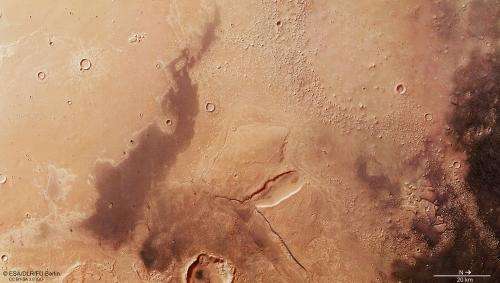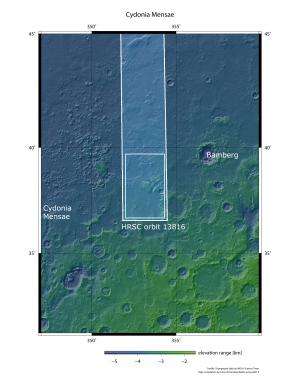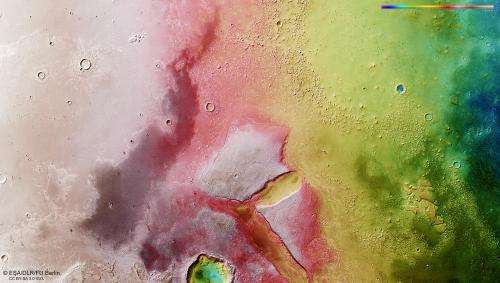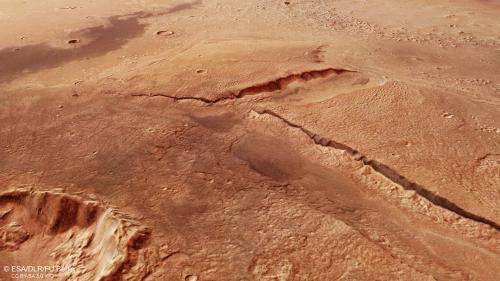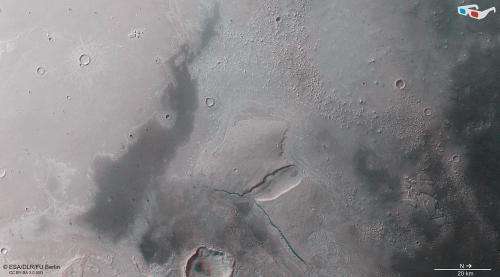Cydonia Mensae. Credit: ESA/DLR/FU Berlin, CC BY-SA 3.0 IGO
On the boundary between the heavily cratered southern highlands and the smooth northern lowlands of Mars is an area rich in features sculpted by water and ice.
Cydonia Mensae is a region of mesa-like structures, craters and otherwise smooth terrain. It is home to the so-called 'Face on Mars' seen in NASA's Viking 1 images, but long since known from subsequent higher-resolution imaging to be just an eroded mesa.
The portion of the Cydonia Mensae region shown here lies to the southeast of the Face, and was imaged by ESA's Mars Express on 19 November 2014.
The region is thought to have hosted ancient seas or lakes that were later covered by hundreds of metres of thick lava and sediment deposits. These deposits were subsequently stripped away by water-driven erosion, leaving the wide debris-filled valleys, scattered mounds and flat-topped mesas of various shapes and sizes.
Some of the remaining mounds have a different surface texture and a higher density of impact craters than their surroundings, suggesting that they were once part of the older southern highlands area.
In the centre of the image there are two large mesas, each roughly 20 km across. Likely once joined together as single block, they are now split by a very broad valley. A much narrower channel cuts through the left-hand (southern) side of the left-hand mesa, with signs of flow all around.
At the lower centre of the image, a 15 km-wide impact crater displays interesting features. Inside its crater walls, material appears to have slumped away from the rim.
Cydonia Mensae in context. Credit: NASA MGS MOLA Science Team
Meanwhile, the debris thrown out from the impact forms a double layer – an inner ejecta blanket covering a larger outer one. This can be seen most clearly in the topography image.
Other smaller impact craters across the region also display smooth floors with raised rims and rounded rings of ejecta around them. This characteristic form suggests that the impacts were into an ice- or water-saturated terrain, which became fluidised and mixed with the rock as the craters formed.
The dichotomy between the rugged southern highlands and smoother northern lowlands is crucial to understanding the overall geological history of the Red Planet, and regions like this transition zone in Cydonia provide a particularly rich set of important clues.
-
The colour-coded topographic view shows a decrease in elevation of nearly 1.5 km across this part of the Cydonia Mensae region of Mars. The more rugged, cratered southern highlands start off beyond the left-hand edge of this image. Credit: ESA/DLR/FU Berlin, CC BY-SA 3.0 IGO
-
Oblique perspective view of two large mesas in the Cydonia Mensae region of Mars. Credit: ESA/DLR/FU Berlin, CC BY-SA 3.0 IGO
-
This anaglyph image showing part of the Cydonia Mensae region of Mars, provides a 3D view of the landscape when viewed using stereoscopic glasses with red–green or red–blue filters. It was derived from data acquired by the nadir channel and one stereo channel of the High Resolution Stereo Camera on ESA’s Mars Express. Credit: ESA/DLR/FU Berlin, CC BY-SA 3.0 IGO
Provided by European Space Agency
